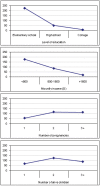A perspective from the practice of swaddling by Turkish mothers
- PMID: 23935268
- PMCID: PMC3738414
A perspective from the practice of swaddling by Turkish mothers
Abstract
Aim: The purpose of this study was to investigate the practice of swaddling by Turkish mothers residing in different areas of the country (rural or urban), and determine to their level of knowledge on its positive and negative effects on children's health.
Material and methods: A total of 632 mothers with an infant aged 0-3 months who presented to our University Hospital volunteered their participation and 598 mothers were included in the study. The study was based on a questionnaire form given to the mothers.
Results: Two hundred eighty three (283) mothers swaddled their infants (47.3 %), while 315 mothers did not swaddle (52.7%). The mothers that swaddled their baby cited tradition ("That's what I learned from my elders") as the most common reason (38%) for swaddling. The most important reason (32%) for not swaddling was the mothers' belief "that it would prevent normal development".
Conclusion: In Turkey, the swaddling tends to decrease with the increase of maternal education level and socio-economic situation.The level of Turkish mother's knowledge about beneficial and adverse effect of swaddling were insufficient.We think that the information about properly swaddling should be given to mothers In order to benefit from it's positive effects and at the same time and avoid its adverse effects.
Keywords: child care; swaddling; traditional methods.
Figures




Similar articles
-
Swaddling and Infant Sleeping Practices.J Community Health. 2017 Feb;42(1):10-14. doi: 10.1007/s10900-016-0219-1. J Community Health. 2017. PMID: 27393144
-
The effect of Russian Maternity Home routines on breastfeeding and neonatal weight loss with special reference to swaddling.Early Hum Dev. 2007 Jan;83(1):29-39. doi: 10.1016/j.earlhumdev.2006.03.016. Epub 2006 May 22. Early Hum Dev. 2007. PMID: 16716541 Clinical Trial.
-
The impact of swaddling upon breastfeeding: A critical review.Am J Hum Biol. 2023 Jun;35(6):e23878. doi: 10.1002/ajhb.23878. Epub 2023 Feb 14. Am J Hum Biol. 2023. PMID: 36787374 Free PMC article. Review.
-
Early contact versus separation: effects on mother-infant interaction one year later.Birth. 2009 Jun;36(2):97-109. doi: 10.1111/j.1523-536X.2009.00307.x. Birth. 2009. PMID: 19489802 Clinical Trial.
-
Swaddling and the Risk of Sudden Infant Death Syndrome: A Meta-analysis.Pediatrics. 2016 Jun;137(6):e20153275. doi: 10.1542/peds.2015-3275. Epub 2016 May 9. Pediatrics. 2016. PMID: 27244847 Review.
Cited by
-
Exploring cultural determinants to be integrated into preterm infant care in the neonatal intensive care unit: an integrative literature review.BMC Pregnancy Childbirth. 2023 Jan 9;23(1):15. doi: 10.1186/s12884-022-05321-7. BMC Pregnancy Childbirth. 2023. PMID: 36624421 Free PMC article. Review.
-
Comparison of the Effect of Nesting and Swaddling on Sleep Duration and Arousal Frequency among Preterm Neonates: A Randomized Clinical Trial.J Caring Sci. 2022 Jul 12;11(3):126-131. doi: 10.34172/JCS.2022.17. eCollection 2022 Aug. J Caring Sci. 2022. PMID: 36247038 Free PMC article.
-
Knowledge and Awareness of Family Physicians as Key Stakeholders Regarding Developmental Dysplasia of the Hip and the Nationwide Screening Program.Acta Orthop Traumatol Turc. 2025 Mar 17;59(1):49-57. doi: 10.5152/j.aott.2025.24034. Acta Orthop Traumatol Turc. 2025. PMID: 40338009 Free PMC article.
-
TRADITIONAL PRACTICES ADOPTED BY JORDANIAN MOTHERS WHEN CARING FOR THEIR INFANTS IN RURAL AREAS.Afr J Tradit Complement Altern Med. 2016 Nov 23;14(1):1-9. doi: 10.21010/ajtcam.v14i1.4499. eCollection 2017. Afr J Tradit Complement Altern Med. 2016. PMID: 28331910 Free PMC article.
References
-
- Liu JH. Generational comparison of paternal child-rearing attitudes and behaviors in Shangai. Psychology. 1995;18:211–215.
-
- Ho DYF, Kang TK. International comparisons of child-rearing attitudes and practices in Hong Kong. Dev Psychol. 1984;20:1004–1016.
-
- Karp H. The Happiest Baby on the Block. London, United Kingdom. Penguin Group. 2002
-
- Masataka N. On the function of swaddling as traditional infant care practiced by native South Americans. Shinrigaku Kenkyu. 1996;67:285–291. - PubMed
-
- 1983 Turkish Population and Health Survey. Ankara. Hacettepe University Institute of Population Studies. 1987
LinkOut - more resources
Full Text Sources
